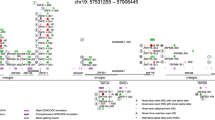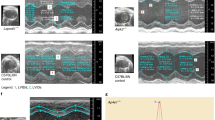Abstract
Background:
We report a new mutation in the human DNAJC19 gene that causes early onset dilated cardiomyopathy syndrome (DCMA).
Methods:
Two brothers of Finnish origin presented with an unusual combination of early onset dilated cardiomyopathy syndrome, a disease which was associated with cardiac noncompaction, microcytic anemia, ataxia, male genital anomalies and methylglutaconic aciduria type V. Suspicion of a DCMA syndrome prompted sequencing of the human DNAJC19 gene.
Results:
Sequencing of the human DNAJC19 gene showed a homozygous single nucleotide (A) deletion in alanine 63 coding triplet in exon 6, which does not immediately cause amino acid change but leads 11 amino acids later to a stop codon and to premature termination of the peptide. This DNAJC19 protein is located in the inner mitochondrial membrane and has been shown to function as a mitochondrial chaperone.
Conclusion:
This is the first clinical report of DCMA syndrome, a human DNAJC19 deficiency, that is related to cases of severe dilated cardiomyopathy diagnosed in Europe. DNAJC19 deficiency causes a relatively specific finding in urinary organic acid analysis (methylglutaconic aciduria type V), which together with the clinical features of the ensuing cardiac disease, allows for effective screening before undertaking molecular genetic analysis.
Similar content being viewed by others
Log in or create a free account to read this content
Gain free access to this article, as well as selected content from this journal and more on nature.com
or
References
Elliott P, Andersson B, Arbustini E, et al. Classification of the cardiomyopathies: a position statement from the European Society Of Cardiology Working Group on Myocardial and Pericardial Diseases. Eur Heart J 2008; 29:270–6.
Maron BJ, Towbin JA, Thiene G, et al. Contemporary definitions and classification of the cardiomyopathies: an American Heart Association Scientific Statement from the Council on Clinical Cardiology, Heart Failure and Transplantation Committee; Quality of Care and Outcomes Research and Functional Genomics and Translational Biology Interdisciplinary Working Groups; and Council on Epidemiology and Prevention. Circulation 2006;113:1807–16.
Davey KM, Parboosingh JS, McLeod DR, et al. Mutation of DNAJC19, a human homologue of yeast inner mitochondrial membrane co-chaperones, causes DCMA syndrome, a novel autosomal recessive Barth syndrome-like condition. J Med Genet 2006;43:385–93.
Sparkes R, Patton D, Bernier F . Cardiac features of a novel autosomal recessive dilated cardiomyopathic syndrome due to defective importation of mitochondrial protein. Cardiol Young 2007;17:215–7.
Wortmann SB, Kluijtmans LA, Engelke UF, Wevers RA, Morava E . The 3-methylglutaconic acidurias: what’s new? J Inherit Metab Dis 2012;35:13–22.
He Q . Tafazzin knockdown causes hypertrophy of neonatal ventricular myocytes. Am J Physiol Heart Circ Physiol 2010;299:H210–6.
Jenni R, Oechslin E, Schneider J, Attenhofer Jost C, Kaufmann PA . Echocardiographic and pathoanatomical characteristics of isolated left ventricular non-compaction: a step towards classification as a distinct cardiomyopathy. Heart 2001;86:666–71.
Bione S, D’Adamo P, Maestrini E, Gedeon AK, Bolhuis PA, Toniolo D . A novel X-linked gene, G4.5. is responsible for Barth syndrome. Nat Genet 1996;12:385–9.
Kampinga HH, Craig EA . The HSP70 chaperone machinery: J proteins as drivers of functional specificity. Nat Rev Mol Cell Biol 2010;11:579–92.
Norton N, Li D, Rieder MJ, et al. Genome-wide studies of copy number variation and exome sequencing identify rare variants in BAG3 as a cause of dilated cardiomyopathy. Am J Hum Genet 2011;88:273–82.
Ichida F, Hamamichi Y, Miyawaki T, et al. Clinical features of isolated noncompaction of the ventricular myocardium: long-term clinical course, hemodynamic properties, and genetic background. J Am Coll Cardiol 1999;34:233–40.
Ergul Y, Nisli K, Demirel A, et al. Left ventricular non-compaction in children and adolescents: clinical features, treatment and follow-up. Cardiol J 2011;18:176–84.
Jenni R, Oechslin EN, van der Loo B . Isolated ventricular non-compaction of the myocardium in adults. Heart 2007;93:11–5.
Bleyl SB, Mumford BR, Brown-Harrison MC, et al. Xq28-linked noncompaction of the left ventricular myocardium: prenatal diagnosis and pathologic analysis of affected individuals. Am J Med Genet 1997;72:257–65.
Arunamata A, Punn R, Cuneo B, Bharati S, Silverman NH . Echocardiographic diagnosis and prognosis of fetal left ventricular noncompaction. J Am Soc Echocardiogr 2012;25:112–20.
Pignatelli RH, McMahon CJ, Dreyer WJ, et al. Clinical characterization of left ventricular noncompaction in children: a relatively common form of cardiomyopathy. Circulation 2003;108:2672–8.
Finsterer J . Cardiogenetics, neurogenetics, and pathogenetics of left ventricular hypertrabeculation/noncompaction. Pediatr Cardiol 2009;30:659–81.
Arad M, Penas-Lado M, Monserrat L, et al. Gene mutations in apical hypertrophic cardiomyopathy. Circulation 2005;112:2805–11.
Acknowledgements
The authors appreciate the assistance of Alexandra Götz in blue native electrophoretic analyses of mitochondrial respiratory chain complexes.
Author information
Authors and Affiliations
Corresponding author
Rights and permissions
About this article
Cite this article
Ojala, T., Polinati, P., Manninen, T. et al. New mutation of mitochondrial DNAJC19 causing dilated and noncompaction cardiomyopathy, anemia, ataxia, and male genital anomalies. Pediatr Res 72, 432–437 (2012). https://doi.org/10.1038/pr.2012.92
Received:
Accepted:
Published:
Issue date:
DOI: https://doi.org/10.1038/pr.2012.92
This article is cited by
-
Cardiac Involvement in Mitochondrial Disorders
Current Heart Failure Reports (2023)
-
Mitochondrial proteins: from biogenesis to functional networks
Nature Reviews Molecular Cell Biology (2019)
-
Absence of Hikeshi, a nuclear transporter for heat-shock protein HSP70, causes infantile hypomyelinating leukoencephalopathy
European Journal of Human Genetics (2017)
-
Left ventricular noncompaction cardiomyopathy: cardiac, neuromuscular, and genetic factors
Nature Reviews Cardiology (2017)
-
The presence of anaemia negatively influences survival in patients with POLG disease
Journal of Inherited Metabolic Disease (2017)



